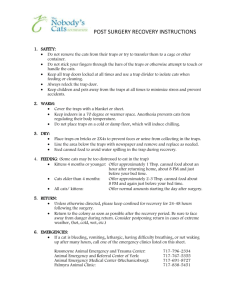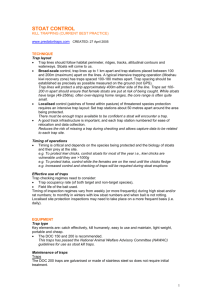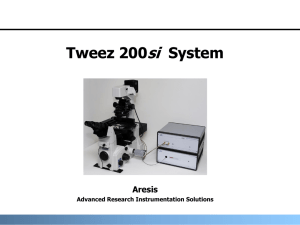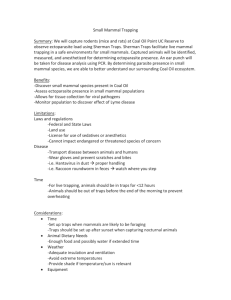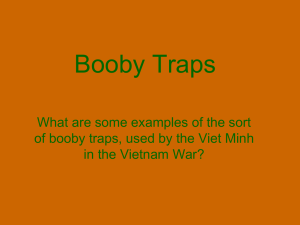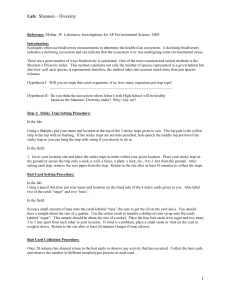Whangarei Heads Landcare Forum Trapping Report 2003
advertisement
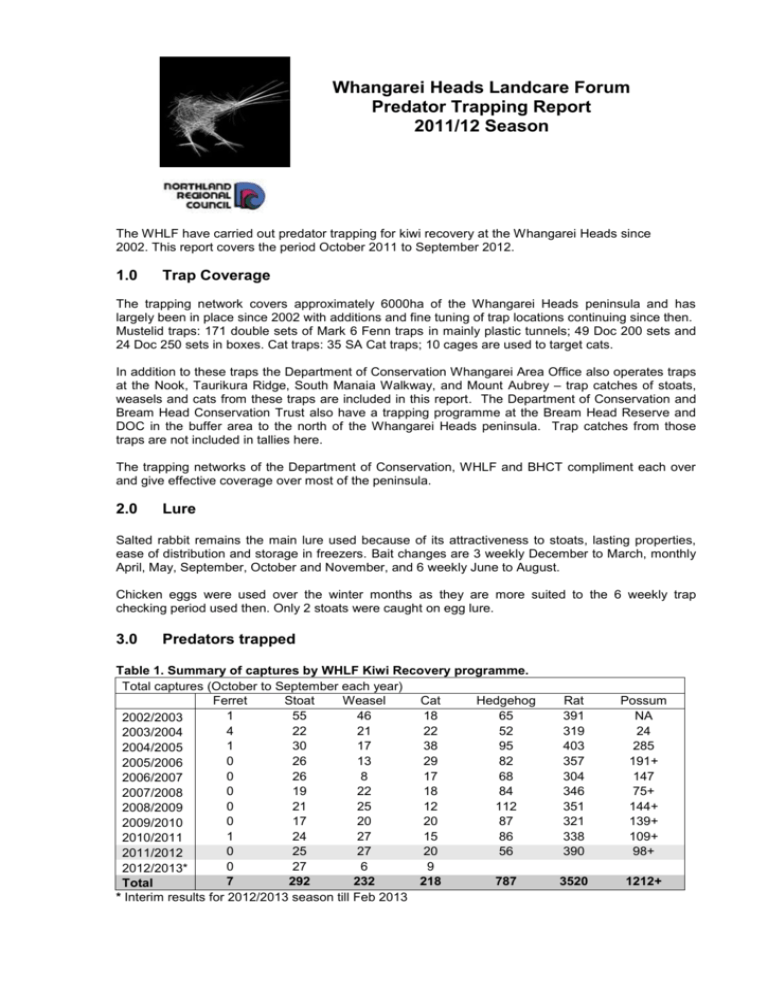
Whangarei Heads Landcare Forum Predator Trapping Report 2011/12 Season The WHLF have carried out predator trapping for kiwi recovery at the Whangarei Heads since 2002. This report covers the period October 2011 to September 2012. 1.0 Trap Coverage The trapping network covers approximately 6000ha of the Whangarei Heads peninsula and has largely been in place since 2002 with additions and fine tuning of trap locations continuing since then. Mustelid traps: 171 double sets of Mark 6 Fenn traps in mainly plastic tunnels; 49 Doc 200 sets and 24 Doc 250 sets in boxes. Cat traps: 35 SA Cat traps; 10 cages are used to target cats. In addition to these traps the Department of Conservation Whangarei Area Office also operates traps at the Nook, Taurikura Ridge, South Manaia Walkway, and Mount Aubrey – trap catches of stoats, weasels and cats from these traps are included in this report. The Department of Conservation and Bream Head Conservation Trust also have a trapping programme at the Bream Head Reserve and DOC in the buffer area to the north of the Whangarei Heads peninsula. Trap catches from those traps are not included in tallies here. The trapping networks of the Department of Conservation, WHLF and BHCT compliment each over and give effective coverage over most of the peninsula. 2.0 Lure Salted rabbit remains the main lure used because of its attractiveness to stoats, lasting properties, ease of distribution and storage in freezers. Bait changes are 3 weekly December to March, monthly April, May, September, October and November, and 6 weekly June to August. Chicken eggs were used over the winter months as they are more suited to the 6 weekly trap checking period used then. Only 2 stoats were caught on egg lure. 3.0 Predators trapped Table 1. Summary of captures by WHLF Kiwi Recovery programme. Total captures (October to September each year) Ferret Stoat Weasel Cat Hedgehog 1 55 46 18 65 2002/2003 4 22 21 22 52 2003/2004 1 30 17 38 95 2004/2005 0 26 13 29 82 2005/2006 0 26 8 17 68 2006/2007 0 19 22 18 84 2007/2008 0 21 25 12 112 2008/2009 0 17 20 20 87 2009/2010 1 24 27 15 86 2010/2011 0 25 27 20 56 2011/2012 0 27 6 9 2012/2013* 7 292 232 218 787 Total * Interim results for 2012/2013 season till Feb 2013 Rat 391 319 403 357 304 346 351 321 338 390 Possum NA 24 285 191+ 147 75+ 144+ 139+ 109+ 98+ 3520 1212+ Comments on 2011/2012 programme by species. Ferrets No ferrets were caught in the 2011-12 season. Although only 1 ferret has be caught since 2004 the trapping network continues to include traps capable of catching ferrets (Mk 6 Fenn traps and Doc 250s) as ferrets are capable of killing sub-adult and adult kiwi. A single ferret can do significant damage to a kiwi population. Stoats 25 stoats were caught in the 2011-12 season, this compares with an average annual catch of 23 stoats over the past 9 years and well down from the peak of 55 in the first season 10 years ago. Catch rates peaked in February at 5 stoats. The stoat kills were more concentrated at the northern end of trapping area probably due to reinvasion from inland areas (see attached map). However the Department of Conservation traps on the peninsula tip of Bream Head accounted for an unusually high 11 stoats over the same period. Also in the Bream Head area a community trapper (Bill Hislop) caught 4 stoats at Urquharts Bay. For the 2012-13 season the BHCT have added another trap line to compliment the existing traps in response to these high stoat catches. Table 2. Kauri Mt E. Manaia W.Manaia Taurikura Nook/Parua Bay Kerr Rd Total Monthly capture stoats Oct Nov Dec Jan Feb 0 1 0 3 0 0 0 0 0 0 1 1 0 1 0 0 0 0 0 3 2 0 3 0 0 2 1 0 1 0 0 4 2 0 5 Mar 1 0 0 0 Apr 0 1 0 0 May 0 0 2 1 Jun 0 0 0 0 Jul 0 0 0 0 Aug 0 0 0 0 Sep 1 0 1 0 Total 6 1 6 4 0 0 1 0 0 1 1 0 4 0 0 0 1 0 1 1 0 1 0 0 2 8 0 25 See section 4.0 of this report for discussion on trap shy stoats within long running trapping systems and use of secondary poisoning as a control method for these animals. Weasels Weasel captures were 27, the same number as the 2010-11 season, up on the average catch tally of 20 of the past 9 seasons but still down from the first season catch of 46. Table 3. Kauri Mt E. Manaia W. Manaia Taurikura The Nook/Parua Bay Kerr Rd Total Monthly capture weasels Oct Nov Dec Jan Feb 0 0 0 0 1 0 0 0 0 0 0 1 0 0 0 1 1 0 0 1 0 0 1 1 0 3 1 0 1 0 0 0 2 0 4 Mar 0 0 0 1 Apr 0 0 0 1 May 1 0 0 1 Jun 0 0 0 3 Jul 0 0 0 0 Aug 0 1 0 0 Sep 0 0 1 1 Total 2 1 2 10 1 0 2 1 0 2 2 1 5 1 0 4 1 0 1 0 0 1 0 1 3 10 2 27 Cats Cat captures were 20 this season, close to the average of 21 of the past 10 seasons and well down from the peak of 38 for the 2004-05 season. The majority of the cats were caught in late summer/autumn. Table 4. Kauri Mt E. Manaia W. Manaia Taurikura The Nook/Parua Bay Kerr Rd Total Monthly capture cats Oct Nov Dec Jan 1 1 0 1 0 0 0 2 0 0 0 0 0 0 0 0 0 0 1 0 0 1 0 0 0 0 0 3 Feb 1 0 2 0 Mar 0 0 1 0 Apr 0 1 0 0 May 1 1 0 0 Jun 0 0 0 1 Jul 0 0 0 0 Aug 1 0 0 0 Sep 0 0 0 0 Total 6 4 3 1 1 0 4 2 0 3 0 0 1 2 0 4 0 0 1 0 0 0 0 0 1 1 0 1 6 0 20 Rats Recorded rat catches in the predator traps totaled 390. 32 Norway rats were identified out of the total (approximately 8%) although many of the trappers do not distinguish between rat species on their records. The rat catch has remained relatively stable for the past 10 seasons. Our rat catches average 352 and range from a low of 304 in 2006-07 to a high of 403 in 2004-05. This indicates that predation by mustelids is probably not a limiting factor to our rat population. In addition to these rat catches individual projects within the WHLF project area carry out targeted rat control. These results are not included in this report. Possums Again in addition to the 98 possums caught in the predator traps (mainly the SA cat traps) possum control projects have been continued by individual Landcare projects within the Whangarei Heads Landcare Forum with significant catch results. The results of those projects are not included in this report. The improved forest health and drastically reduced road kill numbers of possums at the Whangarei Heads indicate that the possum population has been significantly reduced over the past decade. The ongoing possum control helped contribute to the pohutukawa season of 2012-13 being the best seen at the Heads for many years. Many Heads gardeners have also expressed their pleasure at the reduced possum numbers with lower activity in their fruit trees. It is of concern that no future possum control is planned by DOC in the Mt Manaia and Kauri Mt Reserves. Hedgehogs This season’s hedgehog catch of 56 is well down on our 10 year average of 79. 4.0 Possible trap/lure shy predators The 2011-12 season’s capture rates for mustelids continue to be well down from our first season and reflect a significantly reduced mustelid population in the area. However Department of Conservation work monitoring kiwi chick survival rates at the Whangarei Kiwi sanctuary has indicated that over time chick survival rates have dropped despite an ongoing long term trapping programme there. This is thought to be due to the generation of some trap/lure shy stoats and emphasises the importance of the attention to detail needed when setting traps including the removal of any old salted rabbit lure from the area completely. DOC trials have shown that by using secondary poisoning it is possible to remove the trap shy stoats. We were fortunate at the Whangarei Heads that DOC carried out a 1080 possum control operation using land based bait-stations at Mt Manaia reserve in the spring of 2010. That operation will have reduced the number of trap shy predators in that area at that time through secondary poisoning. Until recently the use of the toxin Brodifacom (trade name “Pest Off”) has been avoided by the Landcare groups that are part of the WHLF because of the risk of secondary poisoning of non target species, such as kiwi. Now in appropriate areas we are using a controlled pulse of Brodifacom every 3 or 4 years to gain the benefits of secondary poisoning of trap shy stoats and cats while limiting the risk of secondary poisoning to non target species. For the 2011-12 season a controlled pulse of 100 kg of “Pest off” possum toxin was carried out during the spring in the Kauri Mt area. This operation will have reduced the number of trap shy predators in the area through secondary poisoning as well as providing some possum and rat control. 5.0 Community operated traps There continues to be a hard core of community trappers who are well skilled and persistent in their trapping efforts. Thanks must go to these trappers for their dedicated work. Co-ordination of the community trappers by the WHLF trapper was carried out by telephone contacts and site visits to supply bait, carry out trap maintenance, collect records and audit trap setting. The details of ongoing captures and timely reminders for trap maintenance etc were also communicated through the WHLF project manager’s monthly report and emails. 6.0 Funding In July 2011 the WHLF and the Bream Head Conservation Trust (BHCT) signed a “Community Pest Control Area Management Plan” for kiwi predator control with the Northland Regional Council. This CPCA Plan covers a five year period and it is fantastic to have the NRC’s support for this extended period. This funding gives medium term security for the work needed to maintain and increase the huge gains in kiwi recovery achieved in the past decade at the Whangarei Heads. Thanks in particular to Don McKenzie (NRC Biosecurity Senior Programme Manager) and Kane McElrea (NRC Biosecurity Officer) for their support and advice. 7.0 The Program’s Future A new toxin and re-setting traps have been under development for stoat control in NZ for some time. The toxin (PAPP) for the direct poisoning of predators has recently been registered for use. The use of PAPP has been considered and discounted due to the onerous need to notify individuals within 3 km of the treatment area and the labour intensive bait setting requirements. The only commercially available re-setting stoat trap is the Henry A24. 10 of these traps have been purchased and field trialed at the Whangarei Heads and have caught nothing to date. Until an effective long life stoat lure is developed these traps are likely to be ineffective. In the meantime traditional trapping remains the main tool for predator control at the Whangarei Heads. Ongoing trap maintenance and fine tuning of trap positions will continue to be carried out along with the logistical and motivational support of community trappers to maintain the trapping regime and low mustelid numbers. The success of kiwi recovery at the Whangarei Heads not only depends on an effective predator trapping programme but is also reliant on ongoing community engagement to ensure effective dog control occurs. The WHLF “Backyard kiwi” work is crucial to this community engagement. As a long term monitoring tool for the effectiveness of the kiwi recovery project at the Whangarei Heads annual kiwi call counts are carried out. These call counts have continued to increase in the WHLF area. In 2002 call counts were 2.9 calls/hour, in 2012 they had risen to 6 calls/hour. Todd Hamilton WHLF Project Manager March 2013 hamiltont@maxnet.co.nz http://www.backyardkiwi.org.nz/
